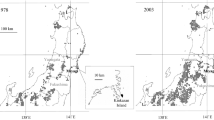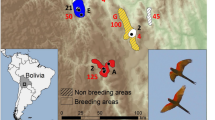Abstract
The structure and dynamics of the present population of Barbary macaques in Gibraltar have already been described in Fa (Chap, 11, this volume). The purpose of this paper is to examine the genetic composition of the population with regard to its health and future conservation.
Access this chapter
Tax calculation will be finalised at checkout
Purchases are for personal use only
Preview
Unable to display preview. Download preview PDF.
Similar content being viewed by others
References
Bliss, C.I., 1953, Fitting the negative binomial distribution to biological data, Biometrics 9: 176–196.
Brass, W., 1958, The distribution of births in human population, Population Studies 12: 51–72.
Cavalli-Sforza, L.L. and Bodmer, W.F., 1971 “The Genetics of Human Populations”, W.H. Freeman and Co., San Francisco.
Deag, J.M., 1973, Intergroup encounters in the wild Barbary macaque Macaca sylvanus L. In: R. Michael and J. Crook (eds.), “Comparative Ecology and Behaviour of Primates”, pp. 315–373. Academic Press., London.
Fa, J.E., 1981, The Apes on the Rock, Oryx XVI: 43–46.
Falconer, D.S., 1960, “Introduction to Quantitative Genetics”, The Ronald Press Co., New York.
Kojima, D., and Kelleher, T.M., 1962, Survival of mutant genes, Am. Nat. 96: 329–343.
Nozawa, K., 1972, Population genetics of Japanese monkeys: I. Estimation of the effective troop size, Primates 13: 381–393.
Rhodes, W., 1982, Differential fertility in Macaca sylvanus of Gibraltar, Ph.D. dissertation, University of Toronto.
Roberts, D.F., 1965, Assumption and fact in anthropological genetics, J. Royal Anthrop. Instit. of Great Britain and Ireland 95: 87–103.
Roholf, F.J. and Sokal, R.R., 1969, “Statistical Tables”, W.H. Freeman and Co., San Francisco.
Taub, D.M ., 1978, Aspects of the biology of the wild Barbary macaque (Primates, Cercopithecinae, Macaca sylvanusL. 1758): Biogeography the mating system and male-infant associations, Ph.D. dissertation, University of California, Davis.
Taub, D.M ., 1980, Female choice and mating strategies among wild Barbary macaques (Macaca sylvanus L.) In: “The Macaques — studies in ecology, behaviour and evolution” (D.G. Lindburg, ed.), pp.287–34, Van Nostrand Reinhold, New York.
Author information
Authors and Affiliations
Editor information
Editors and Affiliations
Rights and permissions
Copyright information
© 1984 Plenum Publishing Corporation
About this chapter
Cite this chapter
Burton, F.D., Sawchuk, L.A. (1984). The Genetic Implications of Effective Population Size for the Barbary Macaque in Gibraltar. In: Fa, J.E. (eds) The Barbary Macaque. Springer, New York, NY. https://doi.org/10.1007/978-1-4613-2785-1_12
Download citation
DOI: https://doi.org/10.1007/978-1-4613-2785-1_12
Publisher Name: Springer, New York, NY
Print ISBN: 978-1-4612-9718-5
Online ISBN: 978-1-4613-2785-1
eBook Packages: Springer Book Archive




